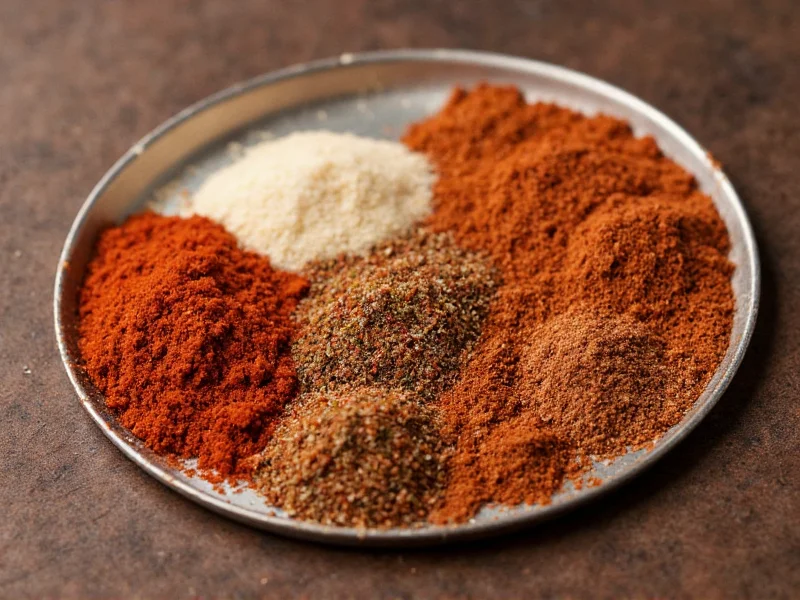Fajita seasoning is a versatile spice blend that transforms ordinary proteins and vegetables into restaurant-quality Mexican-inspired dishes. Understanding exactly what goes into this popular seasoning mix helps home cooks recreate authentic flavors while accommodating dietary preferences and restrictions.
Core Ingredients in Traditional Fajita Seasoning
The magic of fajita seasoning comes from its carefully balanced combination of spices. Each component serves a specific purpose in creating the complex flavor profile that makes fajitas so appealing.
| Ingredient | Typical Percentage | Flavor Contribution |
|---|---|---|
| Chili powder | 25-30% | Base flavor, mild heat, earthy notes |
| Cumin | 20-25% | Earthy, warm, distinctive Mexican flavor |
| Garlic powder | 15-20% | Savory depth, aromatic quality |
| Onion powder | 10-15% | Sweetness, umami foundation |
| Paprika | 8-12% | Color, subtle sweetness, mild heat |
| Dried oregano | 5-8% | Herbal notes, authentic Mexican profile |
| Black pepper | 3-5% | Sharp heat, complexity |
| Salt | 5-10% | Flavor enhancer, balance |
Understanding Each Component's Role
Chili powder forms the foundation of fajita seasoning, providing that characteristic red color and mild heat. Unlike pure cayenne, chili powder contains additional spices that create a more complex base flavor. When selecting chili powder for your blend, look for varieties labeled "chili powder for tamales" for the most authentic results.
Cumin delivers the distinctive earthy note that immediately identifies a seasoning as Mexican-inspired. This spice contains compounds that create that familiar "taco night" aroma. For the best flavor, consider toasting whole cumin seeds before grinding them for your homemade blend.
Garlic and onion powders provide the savory backbone that makes fajita seasoning so versatile. These dehydrated alliums offer consistent flavor without the moisture issues of fresh garlic and onion when applied to proteins before cooking.
Variations Across Commercial and Homemade Blends
While traditional fajita seasoning maintains a consistent core, numerous variations exist depending on regional preferences and manufacturer formulations. Understanding these differences helps you select or create the perfect blend for your needs.
Commercial fajita seasoning blends often contain additional ingredients like:
- Citric acid (for tanginess and preservation)
- Maltodextrin (as a carrier for oils)
- Sugar or dextrose (for caramelization and balance)
- Cayenne pepper (for increased heat)
- Lime zest or citric acid (for brightness)
- Monosodium glutamate (for umami enhancement)
When making your own homemade fajita seasoning, you control exactly what goes into the blend. This approach offers several advantages for health-conscious cooks, including the ability to reduce sodium content, eliminate preservatives, and adjust heat levels to personal preference.
Creating Your Perfect Homemade Fajita Seasoning
Producing your own fajita seasoning blend takes just minutes and yields superior flavor compared to most store-bought options. The basic ratio for a standard fajita seasoning blend is:
- 2 tablespoons chili powder
- 1½ tablespoons ground cumin
- 1 tablespoon garlic powder
- 1 tablespoon onion powder
- 1 teaspoon paprika
- 1 teaspoon dried oregano
- ½ teaspoon black pepper
- 1½ teaspoons salt (optional, adjust to taste)
- ½ teaspoon sugar (optional, for balance)
Mix all ingredients thoroughly in a small bowl, then store in an airtight container away from light and heat. Properly stored, homemade fajita seasoning maintains peak flavor for 3-6 months. For enhanced flavor, toast whole spices before grinding them yourself rather than using pre-ground versions.
Customizing Your Fajita Seasoning Blend
One of the greatest advantages of making your own seasoning is the ability to customize it to your specific taste preferences. Consider these adjustments based on your culinary goals:
- For increased heat: Add ¼-½ teaspoon cayenne pepper or a pinch of chipotle powder
- For smokiness: Replace regular paprika with smoked paprika
- For brightness: Add ½ teaspoon dried lime zest or ¼ teaspoon citric acid
- For sweetness: Increase sugar to 1 teaspoon or add a pinch of cinnamon
- For depth: Add ¼ teaspoon coriander or a pinch of cloves
When adjusting recipes, make changes incrementally and taste as you go. Remember that flavors intensify when the seasoning is applied to food and cooked, so your raw seasoning blend should taste slightly milder than your desired final result.
Using Fajita Seasoning Effectively
Proper application makes all the difference in achieving authentic fajita results. For proteins like chicken, steak, or shrimp, use approximately 1½-2 tablespoons of seasoning per pound of meat. Combine the seasoning with 1-2 tablespoons of oil to create a paste that adheres well to the protein.
Allow seasoned proteins to marinate for at least 30 minutes (or up to 4 hours for chicken and steak) before cooking. This gives the spices time to penetrate the surface and develop more complex flavors through the Maillard reaction during cooking.
For vegetables, toss sliced bell peppers and onions with 1 tablespoon of seasoning and 1 tablespoon of oil before cooking. The oil helps the seasoning adhere and promotes proper caramelization.











 浙公网安备
33010002000092号
浙公网安备
33010002000092号 浙B2-20120091-4
浙B2-20120091-4